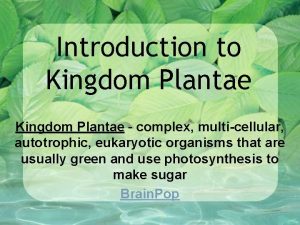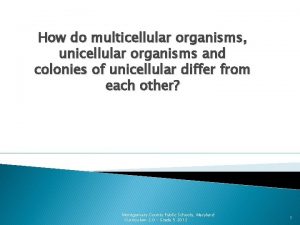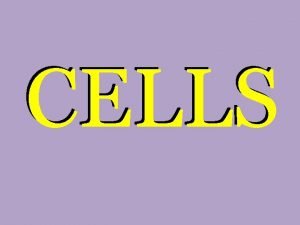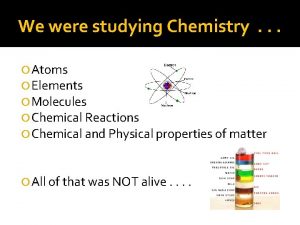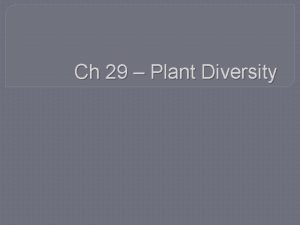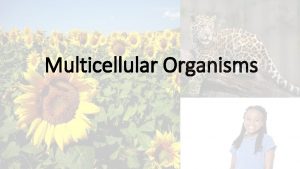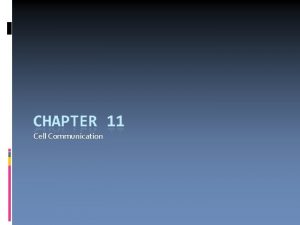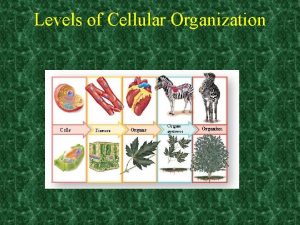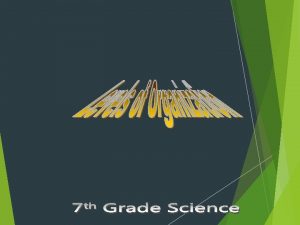Section 4 Reproduction National 5 Multicellular Organisms Learning










- Slides: 10

Section 4 – Reproduction National 5 - Multicellular Organisms

Learning Outcomes �By the end of this lesson I will be able to: �- identify the difference between asexual & sexual reproduction �- identify the sites of gamete production in plants �- identify the key structures of these sites �- explain what happens during fertilisation �- compare the methods of fertilisation in different plants

Reproduction �The production of new members of a species �Can be sexual: �Requires sex cells (gametes) �These contain half the information needed to make a new organism �When they combine, a full set of information is formed �or asexual: �- does not require sex cells

Gametes and reproduction �All body cells have two sets of chromosomes � - 1 set from each parent �These cells are said to be diploid �Gametes are formed by meiosis �- a type of cell division �Gametes contain one set of chromosomes �- half of the original cells �They are said to be haploid �When two haploid cells join together = fertilisation �A new diploid cell is formed �- this is a zygote

Site of gamete production - plants �The reproductive parts of a plant are found in the flower �The male sex cells are found in pollen grains �These are found inside an anther �Female egg cells are called ovules �- found within the ovary

Reproduction in plants - pollination �The transfer of pollen from an anther to a stigma �The stigma is the top of the female part of the flower �Pollen can be transferred in two ways �- by the wind �- by insects

Insect Pollination vs. Wind Pollination �What are the differences in appearance/structure between insect and wind pollinated flowers? WIND INSECT

Insect Pollination vs. Wind Pollination Complete the following table WIND POLLINATED FLOWERS Structural Feature Reason INSECT POLLINATED FLOWERS Structural Feature Small, dull flowers with no scent or nectar Large, colourful flowers with nectar and scent Anthers hanging out of flower Anthers firmly attached inside flower Stigmas hanging out of flower Stigmas inside the flower, with sticky surface Light and smooth pollen Sticky and rough pollen Large quantity of pollen Small quantity of pollen Reason

Insect Pollination vs. Wind Pollination Complete the following table WIND POLLINATED FLOWERS Structural Feature Reason INSECT POLLINATED FLOWERS Structural Feature Reason Small, dull flowers with no scent or nectar Insects not needed Large, colourful To attract insects flowers with nectar and scent Anthers hanging out of flower So pollen is easily Anthers firmly blown away by the attached inside wind flower To brush against insects, so pollen is picked up Stigmas hanging out of flower So pollen can be caught and trapped Stigmas inside the flower, with sticky surface To ensure pollen attached to stigma Light and smooth pollen Easy to be lifted and carried by the wind Sticky and rough pollen Easy for pollen to stick to insects Large quantity of pollen Low chance of pollen landing on another plant Small quantity of pollen More likely to be transferred by insect

Reproduction in plants - fertilisation �Once transferred, the pollen then needs to travel down the stigma �It uses sugar on the stigma as an energy source It uses this to form a pollen tube The male gametes then travel down to the ovule Once inside, the male and female sex cells join together This is fertilisation Plant sexual reproduction video
 Unicellular vs multicellular organisms
Unicellular vs multicellular organisms Multicellular definition
Multicellular definition Unicellular fungi examples
Unicellular fungi examples A multicellular autotrophic organism with vascular tissue
A multicellular autotrophic organism with vascular tissue What is a unicellular organism
What is a unicellular organism Multicellular organisms
Multicellular organisms Multicellular organisms
Multicellular organisms Multicellular organisms
Multicellular organisms Multicellular organisms
Multicellular organisms Diagram of unicellular organism
Diagram of unicellular organism Unicellular and multicellular organisms
Unicellular and multicellular organisms



